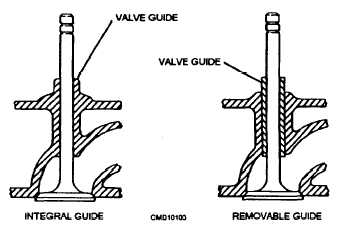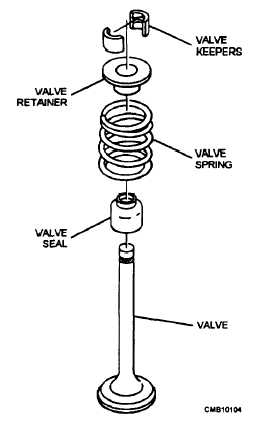of carbon on the contact surface of the seat - a condition that keeps the valve from closing properly. To further reduce carbon build up, there is an interference angle (usually 1 degree) between the valve and seat. In some cases, a small portion of the valve seat has an additional 15-degree angle ground into it to narrow the contact area of the valve face and seat. When you reduce the contact area, the pressure between the mating parts is increased, thereby forming a better seal.
The valve seats may be an integral part of the cylinder head or an insert pressed into the cylinder head. Valve seat inserts are commonly used in aluminum cylinder heads. Steel inserts are needed to withstand the extreme heat. When a valve seat insert is badly worn from grinding or pitting, it must be replaced.
Valve Guides
The valve guides are the parts that support the valves in the cylinder head. They are machined to fit a few thousandths of an inch clearance with a valve stem, This close clearance is important for the following reasons:
It keeps lubricating oil from getting sucked into the combustion chamber past the intake valve stem during the intake stroke.
It keeps exhaust gases from getting into the crankcase area past the exhaust valve stem during the exhaust stroke.
It keeps the valve face in perfect alignment with the valve seat.
Valve guides may be cast integrally with the head, or they may be removable (fig. 3-52). Removable guides are press-fit into the cylinder head.

Figure 3-52. - Valve guides.
Valve Springs, Retainers, Seals, and Valve Rotators
The valve assembly is completed by the spring, the retainer, the seal, and the valve rotator (fig. 3-53). The spring, which keeps the valve in a normally closed position, is basically the same for all engines; however, the number and types of coils can vary. Most valves have only one spring, but, in some cases, there may be two - an inner spring and an outer spring. The second spring increases the pressure holding the valve closed. Low-spring tension can cause valve float (spring too weak to close the valve at high rpm).
A valve retainer and keepers lock the valve spring on the valve. The retainer is a specially shaped washer that fits over the top of the valve spring. The keepers, or locks, fit into the valve stem grooves, holding the retainer and spring in place.
The seal keeps the valve operating mechanism oil from running down the valve stem and into the combustion chamber. Valve seals come in two basic types - umbrella and O ring. Both are common on modern engines. The umbrella valve seal is shaped like a cup and can be made of neoprene plastic or rubber. An umbrella valve seal slides down over the valve stem before the spring and retainer. It covers the small

Figure 3-53. - Valve spring, retainer, and seal.
Continue Reading